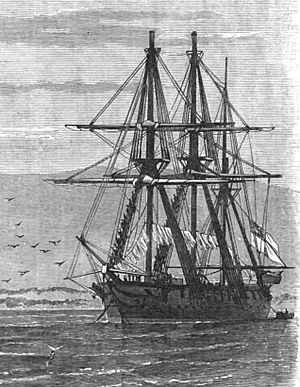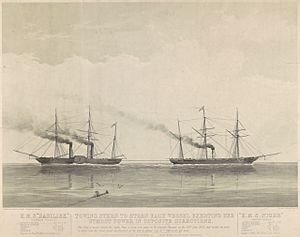HMS Niger (1846) facts for kids

HMS Niger at Vera Crux (Illustrated London News)
|
|
Quick facts for kids History |
|
|---|---|
| United Kingdom | |
| Name | HMS Niger |
| Ordered | 20 February 1845 |
| Builder | Woolwich Dockyard |
| Laid down | May 1845 |
| Launched | 18 November 1846 |
| Honours and awards |
Crimea/Black Sea 1854 - 55, China 56 - 58, New Zealand 1860 |
| Fate | Sold to Castle in 1869 for breaking |
| General characteristics | |
| Class and type | Niger-class |
| Type | wooden screw sloop (later "corvette") |
| Displacement |
|
| Length |
|
| Beam | 34 ft 8 in (10.57 m) maximum, 34 ft 4 in (10.46 m) beam reported for tonnage |
| Draught | 15 ft 6 in (4.72 m) |
| Depth of hold | 21 ft 5.5 in (6.541 m) |
| Installed power | 1002 indicated horsepower |
| Propulsion |
|
| Sail plan | Full-rigged ship |
| Speed | 10.25 kn (18.98 km/h) under power |
| Complement | 160 |
| Armament |
|
HMS Niger was a special ship in the British Royal Navy. It was a wooden screw sloop, which means it was a warship that used both sails and a propeller powered by a steam engine. Niger was ordered on February 20, 1845, and built at Woolwich Dockyard.
This ship was very important because it helped prove that screw propellers were better than paddle wheels for moving ships. Niger served in many parts of the world, including West Africa, the Crimean War, China, and Australia. It also took part in the New Zealand wars in 1860. The ship was eventually sold in 1869 to be taken apart.
Niger was the third ship in the Royal Navy to have this name. The first Niger was a 33-gun ship launched in 1759.
Contents
Building and Features of HMS Niger
The building of Niger started in May 1845 at Woolwich Dockyard. It was officially launched on November 18, 1846. When first built, its main deck was about 185 feet (56.4 meters) long.
In 1848, the ship was made even longer at Deptford Dockyard. Its main deck became about 194 feet (59.1 meters) long. The ship was also wider, measuring about 34 feet (10.6 meters) across at its widest point.
How Niger Moved
Niger's engine was built by Maudslay, Sons & Field. It had a 4-cylinder steam engine that could produce 400 nominal horsepower. This engine powered a single propeller that was 12 feet 6 inches (3.8 meters) wide.
Later, in 1864, the ship got a new, more powerful engine. This new engine could produce 350 nominal horsepower.
What Weapons Did Niger Have?
When Niger was first planned in 1849, it was meant to have several powerful guns. These included a large 56-pounder gun and other 8-inch and 32-pounder guns.
However, when the ship was ready for service in 1850, its weapons were changed. It was equipped with fourteen 32-pounder guns. In 1856, an even bigger 68-pounder gun was added.
Important Trials and Tests
During its speed tests, Niger's engine produced 1,002 horsepower, allowing the ship to reach a speed of 10.25 knots (about 19 kilometers per hour).
In 1849, Niger took part in famous trials in the English Channel against another ship called HMS Basilisk. Both ships were designed to be similar, but Niger used a screw propeller, while Basilisk used paddle wheels.
These tests were very important. They clearly showed that screw propellers were much better than paddle wheels for moving warships. This discovery changed how naval ships were built from then on.
HMS Niger was fully ready for sea on August 16, 1850. Its initial cost was 57,597 pounds.
Niger's First Journey
Niger officially began its first period of service on July 9, 1850, at Portsmouth. It was commanded by Commander Leopold G. Heath. The ship's first mission was to serve on the West Coast of Africa.
Towards the end of 1852, Niger moved to the Mediterranean Sea. In 1854, it was sent to the Black Sea to take part in the Crimean War against Russia. On February 2, 1855, Commander Henry W. Hire took command. The ship finished this period of service on January 31, 1856, at Woolwich.
Niger's Second Journey
After a short break, Niger started its second period of service on May 14, 1856. Captain Arthur A.L.P. Cochrane was in charge. This time, the ship was sent to the East Indies Station and China Station. It was involved in the Second Anglo-Chinese War.
In September 1858, Captain Peter Cracroft took command. In 1860, Niger moved to the Australian Station and played a role in the New Zealand War from 1860 to 1861.
The First Taranaki War in New Zealand
On March 28, 1860, during the First Taranaki War in New Zealand, a group of about 60 marines and sailors from HMS Niger landed at Waireka. They were there to help in a battle.
They reached a fortified area called the Omata stockade. Then, they bravely attacked a Māori fort called Kaipopo Pā. A sailor named William Odgers was incredibly brave. He broke through the fort's defenses and pulled down the Māori flags. For his courage, he received the first Victoria Cross ever given during the New Zealand wars.
On March 30, 1860, HMS Niger also fired its guns at Māori positions near Warea. Later in 1860, a group of marines from the ship stayed to guard a place called Fort Niger. This fort was on a hill overlooking the town of New Plymouth. Today, that hill is a public park. Niger then returned home, finishing its service on September 13, 1861.
Niger's Third Journey
On February 3, 1865, Niger began its third period of service. Captain John C. Byng was the commander. This time, the ship was sent to the North America and West Indies Station.
On March 3, 1865, HMS Niger accidentally ran aground (got stuck) in the River Thames at Greenhithe. It was pulled free and taken to Chatham for repairs. Captain James M. Bruce took command in October 1865. In late 1868, the ship returned to its home waters.
What Happened to Niger?
When HMS Niger arrived back home, it was taken out of service on December 9, 1868. It was then sold to a company called Henry Castle & Sons on December 2, 1869. They took the ship apart for its materials in Charlton.


